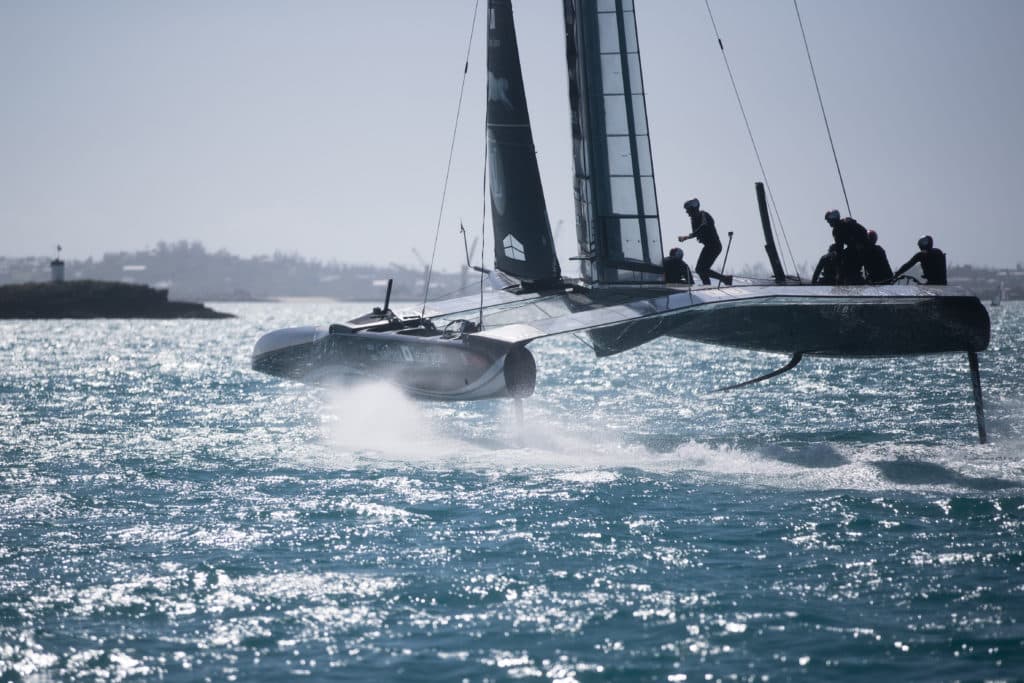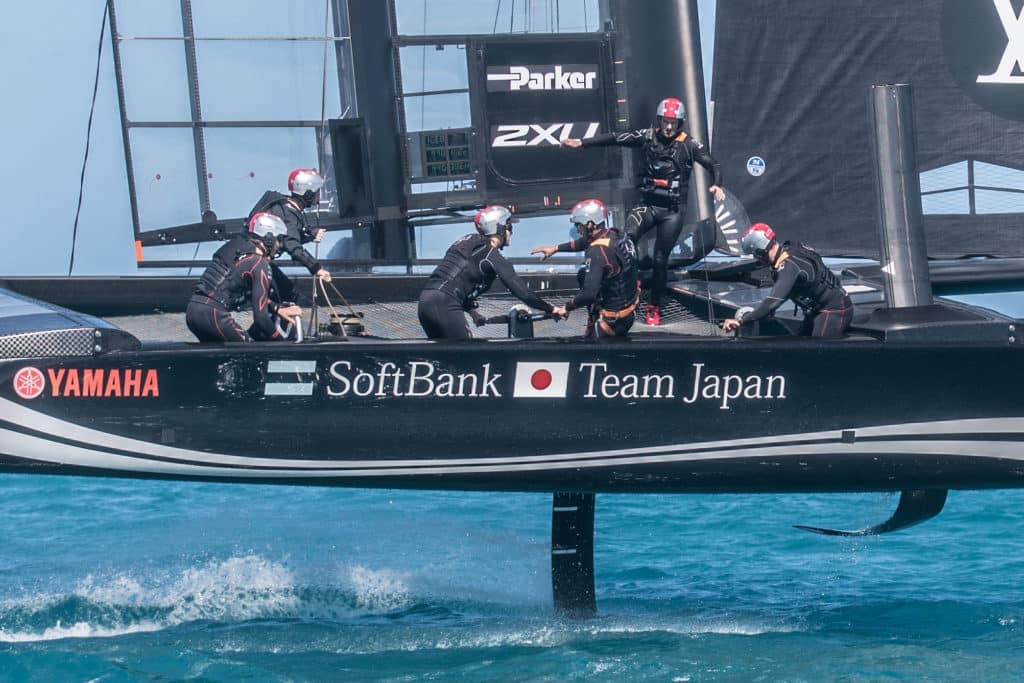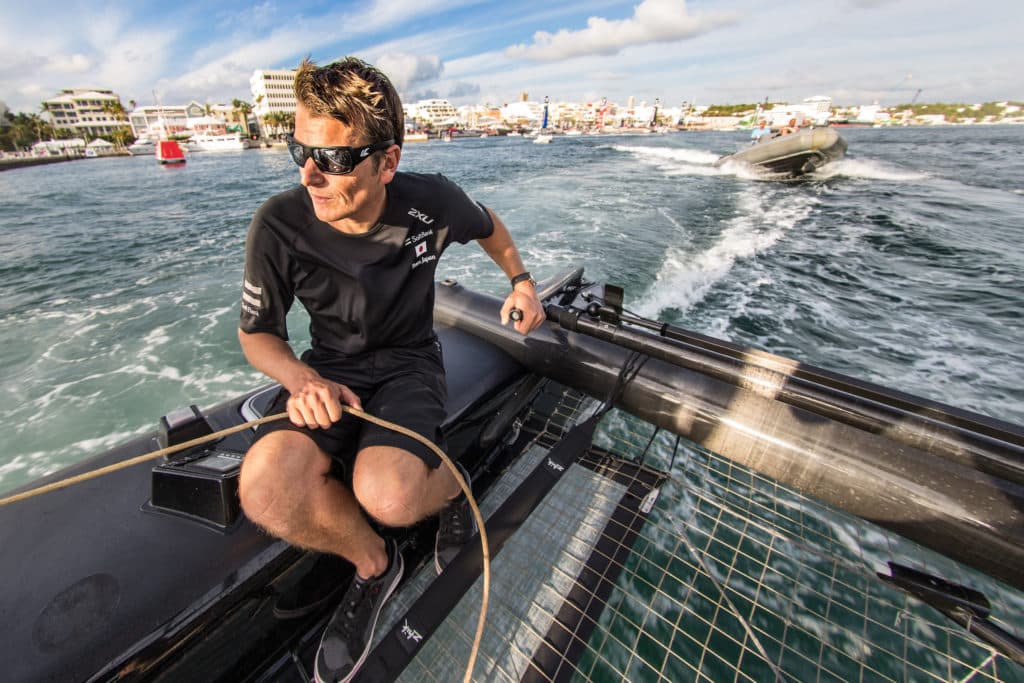
Dean Barker is dressed head to toe in tight black sailing gear, his scarred white helmet tucked under his right arm. As he gazes across Bermuda’s Great Sound, painted by the orange hues of a winter sunset, he gnaws at an apple in his left hand. The shore team hustles to crane the 50-foot catamaran Hikari from the water and place it into its cradle before dark. They’ve seized upon a late-afternoon breeze to take the boat for its second break-in, which amounts to a 90-minute systems check.
Off in the distance, Land Rover BAR’s crane is idle, the base deserted; the British challengers had pulled the plug earlier after waiting all afternoon for wind. But Barker and his teammates don’t have such a luxury. The clock ticks, and the very competition that trampled his spirit is now fewer than 100 days out. It’s already late February, and while the winds on Great Sound have barely touched 5 knots, every minute on the water will count for something come June.
The 6-foot-4-inch and steely-eyed 44-year-old Barker is one of the most complex and curious characters of the modern America’s Cup. He’s a thick-skinned New Zealander to the core: guarded, pensive and loyal to a fault. His sixth America’s Cup is looming, and while he appears relaxed after the short sailing session on the new boat, the burden upon on his broad shoulders is real. For it was not long ago, in San Francisco in 2013, when Barker, at the helm of an Emirates Team New Zealand’s AC72, found himself on the receiving end of Oracle Team USA’s comeback shocker. Barker — stoic and gracious in defeat at the time — stood proudly with his mates, but critics back home gave it to him on the chin.
His subsequent divorce from Emirates Team New Zealand after nearly 20 years was inevitable. The parting was messy, but as one door closed in Auckland, the next opened in Tokyo, at threshold of Masayoshi Son, the billionaire founder and head of SoftBank, an international telecommunications company that’s worth a reported $67 billion.
Son, says Kazuhiko Sofuku, the team’s general manager, was intrigued with the Cup. “He has same philosophy,” says Sofuku. “He likes fast, being number one, and having something that’s challenging. From Japan he is challenging the world, and that is what we are doing.” At the outset of the campaign, says Sofuku, Barker brought over good people with him. “Everyone follows Dean, and the respect they have [for] each other is amazing: It’s attitude and professional,” he says. “We are a team from Japan, and the guys respect our culture, to work hard and be polite. Like Mr. Son did with his business: He started small, and so we are too.”
A flip chart on an easel in the cafeteria reminds the sailors as much: “50=»80” it reads. “50 on the boat…Mateship…Respect for each other.” When I ask what it means, Sofuku says, “We must do with a team of 50 what others do with 80.”
The face of this small and nimble team, of course, is Barker, who I’m told is highly regarded in Cup circles for his ability to delegate and move swiftly with critical decisions, a trait appreciated by the team’s lead designer, Nick Holyrod, another Team New Zealand alumnus. Holyrod is credited with masterminding ETNZ’s foiling 72-footer, which led America’s Cup into its current state of foilers. As far as design-team draft picks, Holyrod is first round. Barker wanted him on his team, as he did longtime teammate Jeremy Lomas, another New Zealander and sage Cup veteran. Lomas was right there beside Barker when ETNZ went down in flames in San Francisco, and three years later, the loss still burns.
“It’s too easy to look back at it and put [the loss] to the races where we were ahead when the races got blown off,” he says. “We arrived sailing the boat at about 90 percent, where Oracle turned up at 50. They kept evolving, and we were tapped out.”
Parting ways with his closest mates and following Barker out the door wasn’t easy, he says, and still weighs on him today. “One of the things I’ll have to deal with is what if Team New Zealand wins …. And that’s still a reality.”
Yet, he has no regrets. For today’s Cup sailor, a job is a job, and for Lomas and several others on the team, Barker was a known variable in an event with so many unknowns. “Dean was the biggest motivator in making my decision,” says Lomas. “I had a lot of sleepless nights, but it’s nice to be sitting in this position now.”

Other veteran ETNZ defectors — on the sailing team alone — include Derek Saward and Winston Macfarlane. Alongside a few Australian and Japanese sailors, the odd man in the lineup, the one with the British passport is 37-year-old Chris Draper, who helmed Luna Rossa’s AC72 in 2013 and is now SoftBank’s onboard strategist.
While the rest of the guys are slaving over their grinding pedestals, Draper is Barker’s co-pilot, his eyes outside the boat. Their dynamic is new and evolving, but he’s happy and learning to follow Barker’s lead.
“Dean’s experience in San Francisco has certainly left him with memories,” says Draper, “but I’ve watched that race many times since, and I remember watching Dean’s speech after the Cup. It was unbelievable …. How anyone can do that is beyond me.”
Not one person on the shore team or the sailing team doubts Barker’s ability to excel under pressure, says Draper. “The closer it gets to the America’s Cup happening, the more we’re seeing that from him. Everyone senses it here. For sure, he’s going to want to right some wrongs.”
When Draper considers mistakes made during the 2016 America’s Cup World Series events — they finished fifth overall — he contributes them to simple communication breakdowns. “That’s the stuff we’re trying to refine,” he says. “We all know Dean can go and win any boat race, and I am capable of making the decision he requires to win sailboat races.”
With Barker preoccupied with flying the 3-ton boat on its foils, he has precious little time and space to consider tactics or his distance to the racecourse’s virtual boundary. For this, he relies on Draper. “It’s really hard to make good decisions when you’re making the boat go fast,” he says, “so we’re finding ways to find that balance, as are the other teams.”
The faster the racing, the more important situational awareness and muscle memory are, says Holyrod. In this regard, Barker’s experience behind the wheel of an AC boat is not to be underestimated. “He’s been racing at this level for so long,” says Holyrod, who sailed against him as a crew on Team New Zealand’s B boat in Valencia. “He understands how maneuvers will unfold, the timing of them, and what he needs to do to make it work. His ability to process the bigger picture of what’s happening on the boat is remarkable.”
What’s also remarkable, says Draper, is Barker’s ability to lead by example and do more with less. “We have one guy doing what perhaps eight others are doing on another team. They might work until bloody 12 o’clock at night, but they’re doing it. We have only 50 people, and we’re going against teams with triple that.”
That human resource figure, however, is slightly misleading because early on in the campaign, SoftBank worked closely with Oracle Team USA, their surrogate and neighbor in Bermuda through a design-package sharing arrangement. The two bases are separated by an unlocked chain-link gate, and they freely pass through each other’s bases and cafeterias. They trained alongside each other all winter long, bound by rules to not share performance data.
As the Louis Vuitton America’s Cup Qualifier races approach, however, they’re keen to draw the divide. “Under no uncertain terms are we the same team as Oracle Team USA,” says Draper. “Every decision we make is for the benefit of our team. Without the support we’ve had from them, there’s no way we’d be competitive, but we’re a small-budget team. I don’t think what we do on the water here in Bermuda reflects us as such.”

Indeed, they’ve laid a few big milestones along the way, claiming to be the first team to complete a foiling tack on the foiling AC45s used for training and development. “That first foiling tack was a case of luck,” Draper confesses. “Oracle was already pretty close to tacking on the foils, but we just happened to beat them to it. They went out a few days later and spent the whole day trying to do one.”
The foiling tack was a shot of confidence in their program. Draper attributes it to being able to move forward with their development while their more cumbersome competitors muddle through the weeds. “I was talking with one of the other guys when we were full of piss at a party, and he was like, ‘One of the things you’ve got is that you don’t have all the f—ing noise. You don’t have the baggage,’” he says. “It’s true, though. We’ll go into a meeting, and in an hour make a bloody big decision.”
Draper puts his faith in Barker to deliver come race time, and he’s also excited to have had Holyrod lead the design team. “He knows how everything works and the engineering of it. He’s not our only designer, but not far off,” says Draper. “He’s highly capable in all areas: rudders, daggerboards, pump — anything — but the one big thing is the foils. It’s a huge part of what this is all about: control systems, foils and wing controls. There’s so much going on, you’re always nearly within one button press of a crash. There is plenty to go wrong.”
With the demand for precision flight control, continually adjusting the three-dimensional movements of the dagger foils, rudders and wing, there’s an absolute demand on efficient hydraulic control systems, the inner workings of which are closely guarded by all teams. The AC50’s magic is hidden in the hulls: a web of pumps, valves, circuits and tubes that deliver power to adjustments throughout the boat.
“If you can sail around the course and always have as much oil as you need to accomplish any maneuver any time,” explains Draper, “you’re going to be so strategically powerful, and that’s why we’re all pushing to the absolute end to fine-tune the control systems. If one guy is able to do three tacks back to back, it’s going to be easy to be able to get a split and get away. Control systems are everything.”
With precision hydraulics, there’s a push toward faster but unstable foils, which places a greater burden on the sailors to maintain consistent flight and maneuverability. When the boat is sailing in a straight line, Barker controls the flight of the boat more than one would realize, says Draper. That means constantly adjusting the foil’s rake while compensating for instantaneous changes in wind strength, crew weight movement, and unpredictable nuances common to sailing.
It’s a skill that requires a hard-wired brain such as Barker’s, and with Holyrod as an ace in hand, SoftBank Team Japan’s storyline in June could very well be a David and Goliath match between the two foes-turned allies. “It would be serious egg on their face if we do beat them,” says Draper. “Imagine the conversation between Dean and Jimmy if we were up on them going into the final race, given what happened last time. That would be absolute gold.” Redemption is a powerful motivator, and while that’s true for both Barker and Emirates Team New Zealand, what makes it different for Barker is that it’s personal. His small posse of loyalists has his back, but should he live to race again, he must fire the first shot, and it had better be on target.









